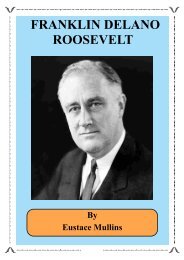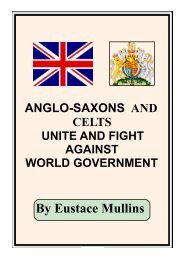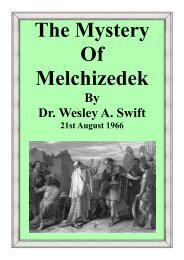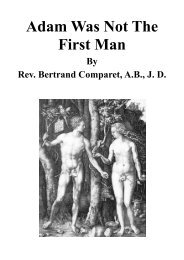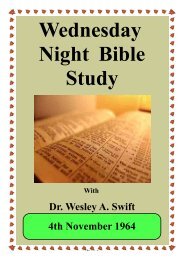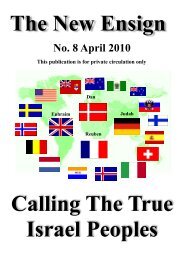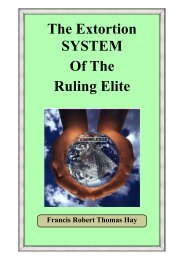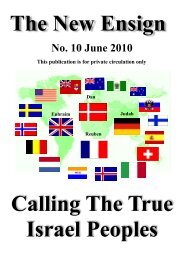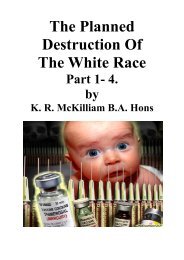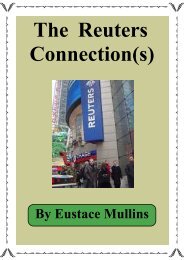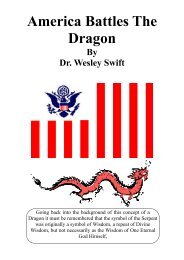Curse of Cannan - The New Ensign
Curse of Cannan - The New Ensign
Curse of Cannan - The New Ensign
Create successful ePaper yourself
Turn your PDF publications into a flip-book with our unique Google optimized e-Paper software.
e a tractable province <strong>of</strong> the British power. From the outset, many <strong>of</strong> the settlers in America<br />
considered themselves to be independent in reality, if not politically. London was a far<strong>of</strong>f<br />
presence, and in most cases, the settlers were left to their own devices. <strong>The</strong> people <strong>of</strong> Shem had<br />
now found their Promised Land, where they could build the type <strong>of</strong> civilization they requried,<br />
and where they could raise their families, free at last from the dread Canaanites and their addiction<br />
to human sacrifice and cannibalism.<br />
However, the Canaanites had not lost sight <strong>of</strong> their prey, far <strong>of</strong>f though they might be. <strong>The</strong>y had<br />
the formula for controlling any people, the subversive organization <strong>of</strong> the Masonic Order <strong>of</strong><br />
Canaanites. <strong>The</strong> Encyclopaedia Judaica notes that Moses M. Hays was appointed inspector<br />
general <strong>of</strong> North American Masonry in 1768. Benjamin Franklin had been Grand Master in<br />
Philadelphia since 1731. Hays soon brought the Scottish Rite into the United States, introducing<br />
it at the <strong>New</strong>port Lodge in 1780. <strong>The</strong> Franklin Masonic organization had been authorized by<br />
Lafayette, who later backed Benito Juarez in the Mexican Revolution. Until the onset <strong>of</strong> the<br />
Scottish Rite, a rival organization set up by the Duc d'Orleans, the Swiss bankers, and British<br />
Intelligence, Franklin had been the chief Masonic organizer in the colonies. By 1785, fiftheen<br />
lodges <strong>of</strong> the Illuminati had been set up in America. <strong>The</strong>y were led by a group <strong>of</strong> <strong>New</strong> Yorkers,<br />
who included Clinton Roosevelt, Charles Dana, Governor DeWitt Clinton, and Horace Greeley.<br />
Roosevelt later wrote an influential book, "<strong>The</strong> Science <strong>of</strong> Government as Founded on Natural<br />
Causes," which became the textbook for the implementation <strong>of</strong> Illuminati programs in America.<br />
<strong>The</strong> American Revolution differed substantially from the revolutions in France, Spain, and<br />
Russia. It was not a local uprising against oppressive masters. Rather, it was the takeover <strong>of</strong><br />
property by those who had worked to develop it, and who felt they owed nothing to the absentee<br />
landlords, the British Crown. <strong>The</strong> Revolution was largely free from the mobs, Reigns <strong>of</strong> Terror,<br />
or the atrocities usually associated with Canaanite Masonic controlled uprisings. Nevertheless,<br />
the same British master <strong>of</strong> espionage, Lord Shelburne, who had run the French Revolution from<br />
London, now contrived to place many <strong>of</strong> his agents in crucial positions among the American<br />
revolutionists. <strong>The</strong>se agents appeared on the seen during critical times and were presented as<br />
able and daring patriots. Just as the Swiss bankers had influenced the French Court by placing<br />
their agent, the financier Necker, in a key position to precipitate an economic depression, so<br />
Lord Shelburne maintained a decisive role in the manipulation <strong>of</strong> the American forces during<br />
the Revolution. <strong>The</strong> most famous <strong>of</strong> these was Benedict Arnold, whose name remains<br />
synonymous with treason. Arnold was merely the most visible <strong>of</strong>ficer in a much larger network<br />
which had been set in place by the Mallet-Prevost family, the single most important name in<br />
Swiss espionage. Augustine Prevost became Grand Steward <strong>of</strong> the Lodge <strong>of</strong> Perfection which<br />
was set up in Albany in 1768. Solomon Bush became Masonic deputy inspector general for<br />
Pennsylvania in 1781, and Abraham Forst <strong>of</strong> Philadelphia was named deputy inspector general<br />
for Virginia in 1781. On October 5, 1785, the Masonic records note that "Brother Augustine<br />
Prevost, a Prince <strong>of</strong> the Royal Secret, was a visitor." In retrospect, we find that Masonic agents<br />
moved freely back and forth between the British zones and the areas controlled by the Americans<br />
throughout the Revolution. During one battle, an English regiment lost its Masonic valuables.<br />
<strong>The</strong>se were promptly returned by General George Washington under a flag <strong>of</strong> truce, and escorted<br />
by a guard <strong>of</strong> honor. After the battle <strong>of</strong> Yorktown in 1781, a great banquet was given at which<br />
British, French, German, and American Masons all sat down and celebrated together.<br />
<strong>The</strong> Prevost family in Geneva, Switzerland, was one <strong>of</strong> the most powerful members <strong>of</strong> the ruling<br />
Council <strong>of</strong> 200. <strong>The</strong> aforementioned General Augustine Prevost, Prince <strong>of</strong> the Royal Secret,<br />
commanded British forces in North America throughout the Revolution; his brother, Mark<br />
Prevost, was his second in command. <strong>The</strong>y wrote the orders for Major Andre, who "ran" the<br />
Benedict Arnold treason operation. Being caught in the act, Andre, the son <strong>of</strong> an influential Swiss<br />
merchant banker, could not be saved. He was hanged by the Americans who had captured him.<br />
America's most famous traitor, Benedict Arnold, went the postwar years comfortably in England.<br />
General Augustine Prevost's son, Sir George Prevost, was commander <strong>of</strong> the British forces in<br />
North America during the War <strong>of</strong> 1812.<br />
( Page 67)



